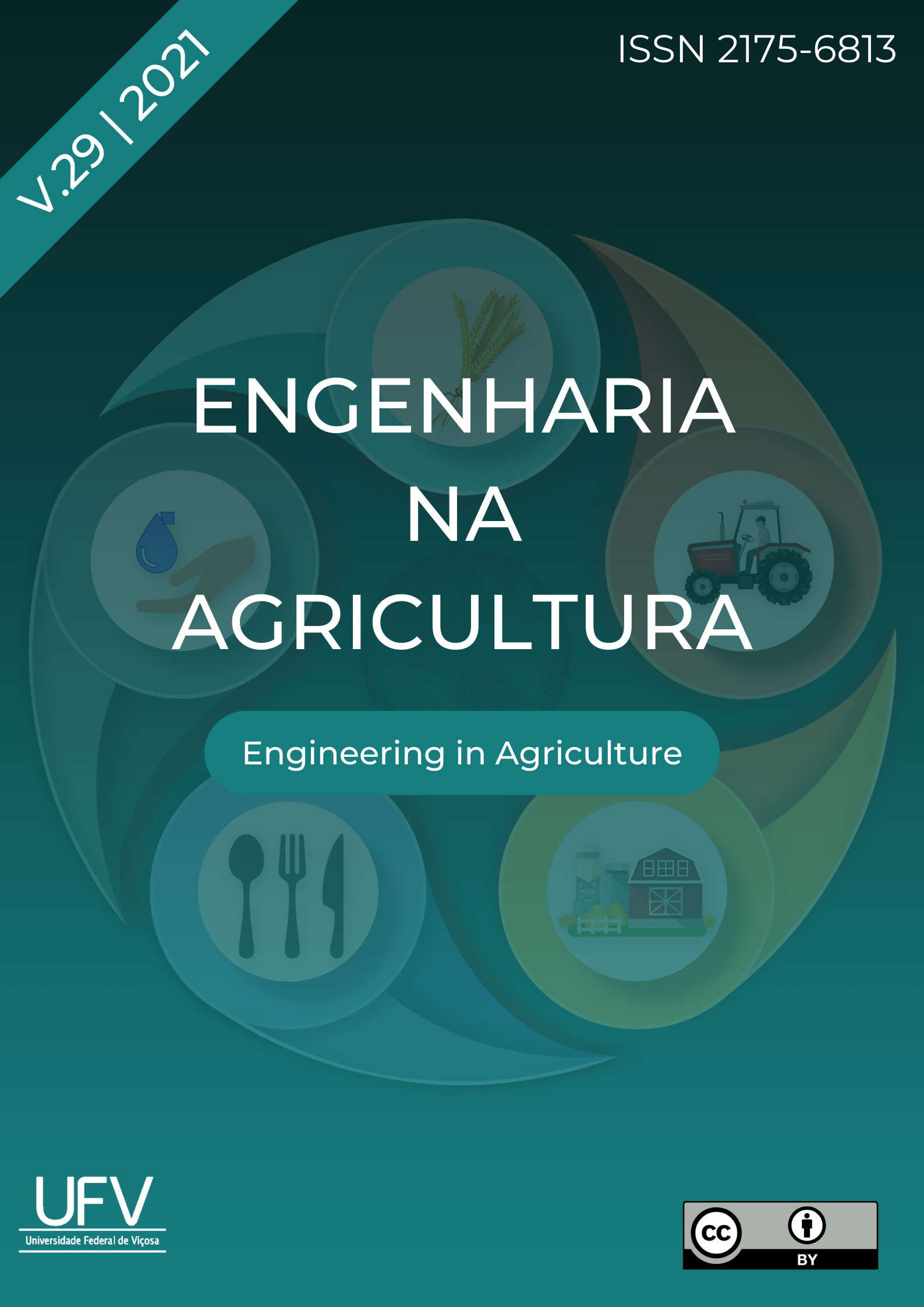Reuse of aquaculture wastewater treated in constructed wetlands
DOI:
https://doi.org/10.13083/reveng.v29i1.12465Keywords:
Dissolved oxygen, Nile tilapia, Water quality, Water recirculationAbstract
Water reuse in fish farming is a practice that has been spreading significantly, therefore requiring more efficient and vigorous treatment systems. The objective of this study was to evaluate the potential reuse of aquaculture wastewater after being treated in horizontal subsurface flow constructed wetlands (HSSF-CW). Three HSSF-CWs with dimensions of 1.0 m in width, 3.0 m in length, and 0.30 m in depth were evaluated. One HSSF-CW had stargrass (Cynodon nlemfuensis) cultivated; the other had cattail (Typha latifolia), and the third was used as a control, where there was no cultivation. The wastewater was provided from three Nile tilapia breeding tanks, which recirculated the entire system after going through the HSSF-CW. The following variables were determined every five days at the HSSF-CW influent and effluent: temperature, pH, turbidity, electrical conductivity, redox potential, dissolved oxygen, ammonium, and nitrate. The treatment in the HSSF-CW allowed the reuse of aquaculture wastewater as it provides water quality levels according to the recommendation for Nile tilapia breeding. Furthermore, the water quality parameters monitored in HSSF-CW effluent remained within limits established by CONAMA Resolution No. 357/2005 for aquaculture and fishing activity.
Downloads
References
AMORIM, R. V. Produção de tilápias do Nilo em sistemas sem renovação de água com wetlands para tratamento de efluentes. Mestrado (Mestrado em Aquicultura). Centro de Aquicultura da UNESP-CAUNESP, Universidade Estadual Paulista, Jaboticabal-SP, 2014.
APHA. Standard Methods for the Examination of Water and Wastewater, 22nd Edition. Washington: American Public Health Association, American Water Works Association, Water Environment Federation, 2012.
ASSUNÇÃO, A. W. A.; JUNIOR, P. G.; ALMEIDA, R. V.; GASPAROTTO, Y.; AMARAL, L. A. Utilização de macrófitas aquáticas de três diferentes tipos ecológicos para remoção de Escherichia coli de efluentes de criação de pacu. Engenharia Sanitaria e Ambiental, v.22, n.4, p.657-663, 2017.
BRASIL. Conselho Nacional do Meio Ambiente (CONAMA). Resolução nº 357, de 17 de março de 2005. Dispõe sobre a classificação dos corpos de água e diretrizes ambientais para o seu enquadramento, bem como estabelece as condições e padrões de lançamento de efluentes, e dá outras providências. Diário Oficial da União, 18 de março de 2005, p.58-63, 2005.
CHAKRAVARTTY, D.; MONDAL, A.; RAYCHOWDHURY, P.; BHATTACHARYA, S.B.; MITRA, A. Role of aquaponics in the sustenance of coastal India-Aquaponics is a solution for modern agriculture in ecologically sensitive Indian mangrove Sundarbans: A review. International Journal of Fisheries and Aquatic Studies, v.5, n.2, p.441-448, 2017.
FIA, F.R.L.; MATOS, A.T.; FIA, R.; BORGES, A.C.; CECON, P.R. Efeito da vegetação em sistemas alagados construídos para tratar águas residuárias da suinocultura. Engenharia Sanitária e Ambiental, v.22, n.2, p.303-311, 2017.
HOAGLAND, D. R.; ARNON, D. I. The water-culture method for growing plants without soil. Circular - California Agricultural Experiment Station, v. 347, n. 2nd edit, 1950.
KADLEC, R.H.; WALLACE, S.D. Treatment wetlands. 2. Boca Raton, Fla.: CRC Press, 2009.
KONNERUP, D.; TRANG, N, T, D.; BRIX, H. Treatment of fishpond water by recirculating horizontal and vertical flow constructed wetlands in the tropics. Aquaculture, v.313, p.57-64, 2011.
LO MONACO, P.A.V.; SOELA, D.M.; HADDADE, I.R.; OZA, E.F.; SANTOS, M.M. Tratamento de água residuária de suinocultura em sistemas alagados construídos cultivados com Heliconia psittacorum e Hedychium coronarium. Engenharia na Agricultura, v.25, n.6, p.561-568, 2017.
MATOS, A.T.; FREITAS, W.S.; BRASIL, M.S.; BORGES, A.C. Influência da espécie vegetal cultivada nas condições redox de sistemas alagados construídos. Engenharia Agrícola, v.30, n.3, p.518-526, 2010.
OMOTADE, I.F.; ALATISE, M.O.; OLANREWAJU, O. Recycling of aquaculture wastewater using charcoal based constructed wetlands. International journal of phytoremediation, v.21, n.5, p.399-404, 2019.
OSTI, J.A.; HENARES, M.N.; CAMARGO, A.F. The efficiency of free floating and emergent aquatic macrophytes in constructed wetlands for the treatment of a fishpond effluent. Aquaculture Research, v.49, n.10, p.3468-3476, 2018.
SANTOS, R.M.F.; ROSTON, D.M. Desempenho de alagados construídos (constructed wetlands) de fluxo vertical no pós-tratamento de esgoto sanitário: potencial para o reúso agrícola. Engenharia na Agricultura, v.25, n.6, p.517-528, 2016.
SILVA, M.S.G.M.; LOSEKANN, M.E.; ROSTON, D.M. Avaliação de um sistema de leito cultivado com recirculação para piscicultura. Boletim de Pesquisa e Desenvolvimento (INFOTECA-E). Jaguariúna: Embrapa Meio Ambiente, 2017.
TEIXEIRA, D.L.; MATOS, A.T.; MATOS, M.P.; HAMAKAWA, P.J.; TEIXEIRA, D.V. Evapotranspiration of the Vetiver and Tifton 85 grasses grown in horizontal subsurface flow constructed wetlands. Journal of Environmental Science and Health, Part A, v.55, n.6, p.661-668, 2020.
TEIXEIRA, D.L.; MATOS, A.T.; MATOS, M.P.; MIRANDA, S.T.; TEIXEIRA, D.V. Modeling of productivity and nutrient extraction by the Vetiver and Tifton 85 grasses grown in horizontal subsurface flow constructed wetlands. Journal of Environmental Science and Health, Part A, v.57, n.1, p.1-9, 2021.
VILAS BOAS, R.B.; FIA, R.; FIA, F.R.; CAMPOS, A.T.; SOUZA, G.R.D. Nutrient removal from swine wastewater in a combined vertical and horizontal flow constructed wetland system. Engenharia Agrícola, v.38, n.3, p.411-416, 2018.
Downloads
Published
How to Cite
Issue
Section
License
Copyright (c) 2021 Revista Engenharia na Agricultura - Reveng

This work is licensed under a Creative Commons Attribution-NonCommercial 4.0 International License.
Authors who publish with this journal agree to the following terms:
The author(s) authorize(s) the publication of the text in the journal;
The author(s) ensure(s) that the contribution is original and unpublished and that it is not in the process of evaluation by another journal;
The journal is not responsible for the views, ideas and concepts presented in articles, and these are the sole responsibility of the author(s);
The publishers reserve the right to make textual adjustments and adapt texts to meet with publication standards.
From submission, the author is fully conceding the paper's patrimonial rights to the publication, but retaining the owner of its moral rights (authorship and paper's identification) according to Creative Commons Attribution-Noncommercial.








 Licensed by
Licensed by 